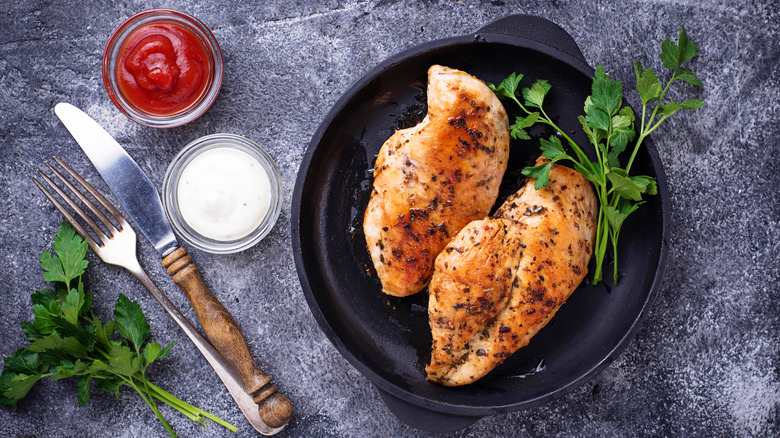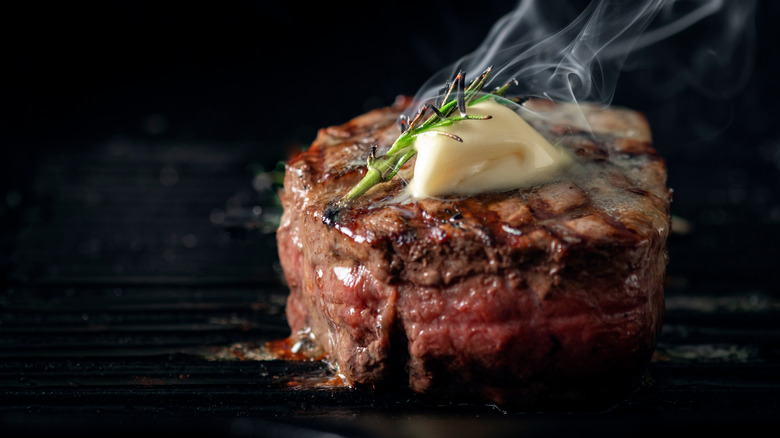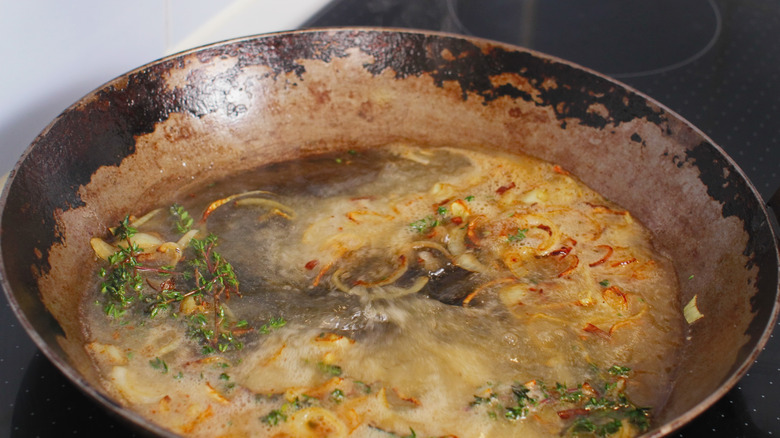The Pan Temperature You Need To Remember When Cooking Meat
Cooking meat isn't exactly rocket science — at least on paper. What's so hard about putting a strip of bacon or a chicken breast in a pan and cooking it until it's no longer raw and smells pretty good? While it's true that you don't need much kitchen expertise to fry up some meat, it's one of those very basic skills that you should build on if you want to make a really good meal.
For example, you'll want to know whether your chicken breast or cut of steak is better off being cooked in oil or butter. Despite these ingredients being very good for cooking, they differ in smoke points, or the temperature at which they begin to smoke and burn. You should also be aware of when to flip your meat, as the moment you do so can help give you a delicious golden-brown crust on the exterior — or not.
Pan-cooking meat is simple, but it also requires careful attention to different factors to ensure the best possible result. One of these, of course, is the heat. You not only need to ensure that your stovetop is set to the right temperature, but also that your pan is sufficiently heated.
Keep your pan at around 280 degrees Fahrenheit
Whenever you cook meat on the stovetop, you probably set the pan over the burner, add some butter or oil, and then add your choice of meat once the fat inside the pan seems hot. While this is a universally accepted cooking method, you should also be paying attention to just what temperature your pan is at.
Jarret Melendez of Epicurious spoke to author and BBC food science presenter Dr. Stuart Farrimond on how to best achieve the Maillard reaction — or the science behind that coveted golden crust on your meat. Farrimond explained that in order to start the Maillard reaction quickly, the cooking vessel should be at least 280 degrees Fahrenheit. This high of a temperature is key because it allows the surface moisture on the meat to evaporate as soon as it hits the pan. Excess moisture prevents the browning process, as the energy from the hot pan is focused on evaporating the water rather than actually cooking the meat. If your pan is lower than 280 degrees, then, the meat will still cook, but it won't get that golden crust you're expecting.
On a related note, another tip from Farrimond is to dry your meat with a paper towel before adding it to the pan. This way, even if your pan is a little too cool, the lower moisture level will enable better browning.
A very hot pan also helps you get fond
Have you ever cooked a pork chop in a skillet, then tutted at the "dirty" stuff left behind? The truth is that these crispy brown bits are actually known as fond — and they can create a delicious pan sauce.
Fond is achieved when you have your pan set at a very high temperature, much like how the crust on your meat is formed during the Maillard reaction. The proteins found in your meat become crusty and brown, sticking to the pan as you cook it. Just as that golden crust gives your meat a deeper, richer flavor, it's those same proteins that gather and caramelize on the pan itself. Unlike burnt grease or oil, these proteins can be reused and shouldn't be thrown away (if there is oil in your pan, it's recommended to drain it off and focus on the sticky caramelized bits at the bottom).
To reuse fond, simply deglaze your pan with your choice of liquid, such as red or white wine or chicken stock. These liquids, now infused with the flavor left behind in those pools of fond, can then be used to make a variety of sauces or gravies to serve alongside your meat. If your pan isn't hot enough, however, you won't be able to get as much fond as you'd hope.


